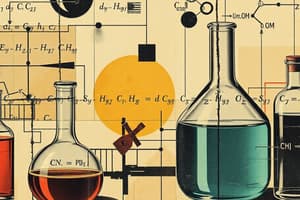Podcast
Questions and Answers
Given the unbalanced equation $N_2 + H_2 \rightarrow NH_3$, what is the mole ratio of $H_2$ to $NH_3$ in the balanced reaction?
Given the unbalanced equation $N_2 + H_2 \rightarrow NH_3$, what is the mole ratio of $H_2$ to $NH_3$ in the balanced reaction?
3:2
If 25.0 grams of ammonium nitrate ($NH_4NO_3$) decomposes, according to the unbalanced equation $NH_4NO_3 \rightarrow N_2O + H_2O$, what mass of water ($H_2O$) is produced?
If 25.0 grams of ammonium nitrate ($NH_4NO_3$) decomposes, according to the unbalanced equation $NH_4NO_3 \rightarrow N_2O + H_2O$, what mass of water ($H_2O$) is produced?
11.3 g $H_2O$
For the reaction $TiO_2 + C + Cl_2 \rightarrow TiCl_4 + CO_2$, how many grams of chlorine gas ($Cl_2$) are needed to react completely with 2.35 moles of titanium dioxide ($TiO_2$)?
For the reaction $TiO_2 + C + Cl_2 \rightarrow TiCl_4 + CO_2$, how many grams of chlorine gas ($Cl_2$) are needed to react completely with 2.35 moles of titanium dioxide ($TiO_2$)?
333 g $Cl_2$
In the reaction $NH_3 + O_2 \rightarrow H_2O + NO$, if 15.8 grams of ammonia ($NH_3$) reacts with excess oxygen, how many moles of water vapor ($H_2O$) are expected to form?
In the reaction $NH_3 + O_2 \rightarrow H_2O + NO$, if 15.8 grams of ammonia ($NH_3$) reacts with excess oxygen, how many moles of water vapor ($H_2O$) are expected to form?
For the combustion of propane ($C_3H_8$) according to the unbalanced equation $C_3H_8 + O_2 \rightarrow H_2O + CO_2$, how many moles of oxygen ($O_2$) are required to completely combust 1.27 moles of propane?
For the combustion of propane ($C_3H_8$) according to the unbalanced equation $C_3H_8 + O_2 \rightarrow H_2O + CO_2$, how many moles of oxygen ($O_2$) are required to completely combust 1.27 moles of propane?
If you have 4.66 g of $N_2$, determine how many grams of $H_2$ are needed to fully react and produce $NH_3$?
If you have 4.66 g of $N_2$, determine how many grams of $H_2$ are needed to fully react and produce $NH_3$?
For the reaction $2NaOH + H_2SO_4 \rightarrow 2H_2O + Na_2SO_4$, how does increasing the amount of $H_2SO_4$ affect the amount of $Na_2SO_4$ produced, assuming $NaOH$ is the limiting reactant?
For the reaction $2NaOH + H_2SO_4 \rightarrow 2H_2O + Na_2SO_4$, how does increasing the amount of $H_2SO_4$ affect the amount of $Na_2SO_4$ produced, assuming $NaOH$ is the limiting reactant?
In the reaction $N_2 + 3H_2 \rightarrow 2NH_3$, if you start with 2 moles of $N_2$ and 5 moles of $H_2$, identify the limiting reactant.
In the reaction $N_2 + 3H_2 \rightarrow 2NH_3$, if you start with 2 moles of $N_2$ and 5 moles of $H_2$, identify the limiting reactant.
Consider the reaction $C_3H_8 + 5O_2 \rightarrow 3CO_2 + 4H_2O$. If 10 moles of $C_3H_8$ are reacted with 40 moles of $O_2$, what is the theoretical yield of $CO_2$ in moles?
Consider the reaction $C_3H_8 + 5O_2 \rightarrow 3CO_2 + 4H_2O$. If 10 moles of $C_3H_8$ are reacted with 40 moles of $O_2$, what is the theoretical yield of $CO_2$ in moles?
If the actual yield of $H_2O$ in the reaction $C_3H_8 + 5O_2 \rightarrow 3CO_2 + 4H_2O$ is 14.4 moles when 5 moles of $C_3H_8$ are reacted, what is the percent yield of the reaction?
If the actual yield of $H_2O$ in the reaction $C_3H_8 + 5O_2 \rightarrow 3CO_2 + 4H_2O$ is 14.4 moles when 5 moles of $C_3H_8$ are reacted, what is the percent yield of the reaction?
For the reaction $2K + Cl_2 \rightarrow 2KCl$, if 7.84 grams of $K$ are allowed to react with excess $Cl_2$, what is the theoretical yield of $KCl$ in grams?
For the reaction $2K + Cl_2 \rightarrow 2KCl$, if 7.84 grams of $K$ are allowed to react with excess $Cl_2$, what is the theoretical yield of $KCl$ in grams?
If the percent yield of a reaction is 85% and the theoretical yield is 40.0 grams, what is the actual yield of the product?
If the percent yield of a reaction is 85% and the theoretical yield is 40.0 grams, what is the actual yield of the product?
Given the balanced equation $4NH_3 + 5O_2 \rightarrow 4NO + 6H_2O$, if 34.0 grams of ammonia ($NH_3$) are reacted with excess oxygen, what mass of water ($H_2O$) is produced?
Given the balanced equation $4NH_3 + 5O_2 \rightarrow 4NO + 6H_2O$, if 34.0 grams of ammonia ($NH_3$) are reacted with excess oxygen, what mass of water ($H_2O$) is produced?
For the reaction $2H_2 + O_2 \rightarrow 2H_2O$, if you start with 4.0 grams of $H_2$ and 32.0 grams of $O_2$, which reactant will be completely consumed?
For the reaction $2H_2 + O_2 \rightarrow 2H_2O$, if you start with 4.0 grams of $H_2$ and 32.0 grams of $O_2$, which reactant will be completely consumed?
Consider the reaction $C_6H_{12}O_6 \rightarrow 2C_2H_5OH + 2CO_2$. If 90.0 g of $C_6H_{12}O_6$ goes to completion, what is the theoretical mass yield of $C_2H_5OH$?
Consider the reaction $C_6H_{12}O_6 \rightarrow 2C_2H_5OH + 2CO_2$. If 90.0 g of $C_6H_{12}O_6$ goes to completion, what is the theoretical mass yield of $C_2H_5OH$?
In a chemical reaction, what does the term 'stoichiometric coefficients' refer to, and how are they used in stoichiometric calculations?
In a chemical reaction, what does the term 'stoichiometric coefficients' refer to, and how are they used in stoichiometric calculations?
How does the concept of 'limiting reactant' influence the maximum amount of product that can be formed in a chemical reaction?
How does the concept of 'limiting reactant' influence the maximum amount of product that can be formed in a chemical reaction?
Explain the difference between 'theoretical yield' and 'actual yield' in a chemical reaction, and what does the percent yield represent?
Explain the difference between 'theoretical yield' and 'actual yield' in a chemical reaction, and what does the percent yield represent?
If a reaction has a high percent yield, does this always indicate that the reaction was performed without any errors or loss of product? Explain.
If a reaction has a high percent yield, does this always indicate that the reaction was performed without any errors or loss of product? Explain.
A student performs a reaction and calculates a theoretical yield of 25.0 grams of product. If their actual yield is 20.0 grams, explain two potential reasons why the actual yield is less than the theoretical yield.
A student performs a reaction and calculates a theoretical yield of 25.0 grams of product. If their actual yield is 20.0 grams, explain two potential reasons why the actual yield is less than the theoretical yield.
Consider a scenario where two different reactions produce the same product. Explain how stoichiometry can be used to determine which reaction is more efficient in producing the desired product.
Consider a scenario where two different reactions produce the same product. Explain how stoichiometry can be used to determine which reaction is more efficient in producing the desired product.
Explain why it is important to balance a chemical equation before performing stoichiometric calculations.
Explain why it is important to balance a chemical equation before performing stoichiometric calculations.
In the context of stoichiometry, what is the significance of Avogadro's number, and how is it used in converting between moles and number of particles (atoms, molecules, ions)?
In the context of stoichiometry, what is the significance of Avogadro's number, and how is it used in converting between moles and number of particles (atoms, molecules, ions)?
Describe how the concepts of stoichiometry are applied in real-world scenarios, outside of a chemistry laboratory setting.
Describe how the concepts of stoichiometry are applied in real-world scenarios, outside of a chemistry laboratory setting.
How does the presence of impurities in a reactant affect the accuracy of stoichiometric calculations used to predict the amount of product formed?
How does the presence of impurities in a reactant affect the accuracy of stoichiometric calculations used to predict the amount of product formed?
Flashcards
Stoichiometry
Stoichiometry
The quantitative relationship between two or more substances during a chemical reaction.
Steps for Stoichiometry Problems
Steps for Stoichiometry Problems
- Balance the equation.
- Convert grams to moles.
- Use the molar ratio to convert moles of the given substance to moles of the desired substance.
- Convert moles back to grams if necessary.
Mole (mol)
Mole (mol)
A measure of the amount of substance, 1 mole contains Avogadro's number (6.022 x 10^23) of particles.
Molar Mass
Molar Mass
Signup and view all the flashcards
Molar Ratio
Molar Ratio
Signup and view all the flashcards
Balanced Equation
Balanced Equation
Signup and view all the flashcards
Unbalanced Equation for Sodium Hydroxide and Sulfuric Acid
Unbalanced Equation for Sodium Hydroxide and Sulfuric Acid
Signup and view all the flashcards
Balanced Equation for Sodium Hydroxide and Sulfuric Acid
Balanced Equation for Sodium Hydroxide and Sulfuric Acid
Signup and view all the flashcards
Unbalanced Equation for Nitrogen and Hydrogen
Unbalanced Equation for Nitrogen and Hydrogen
Signup and view all the flashcards
Balanced Equation for Nitrogen and Hydrogen
Balanced Equation for Nitrogen and Hydrogen
Signup and view all the flashcards
Unbalanced Equation for Ammonium Nitrate
Unbalanced Equation for Ammonium Nitrate
Signup and view all the flashcards
Balanced Equation for Ammonium Nitrate
Balanced Equation for Ammonium Nitrate
Signup and view all the flashcards
Unbalanced Equation for Titanium Dioxide
Unbalanced Equation for Titanium Dioxide
Signup and view all the flashcards
Balanced Equation for Titanium Dioxide
Balanced Equation for Titanium Dioxide
Signup and view all the flashcards
Unbalanced Equation for Ammonia and Oxygen
Unbalanced Equation for Ammonia and Oxygen
Signup and view all the flashcards
Balanced Equation for Ammonia and Oxygen
Balanced Equation for Ammonia and Oxygen
Signup and view all the flashcards
Unbalanced Equation for Propane
Unbalanced Equation for Propane
Signup and view all the flashcards
Balanced Equation for Propane
Balanced Equation for Propane
Signup and view all the flashcards
Study Notes
- Stoichiometry practice stations are designed for collaborative learning at individual paces
- These stations help students practice and become proficient in stoichiometric calculations
- Answer keys and problem setups are printed on the back of each station
Topics Covered
- Mole-to-mole calculations
- Gram-to-mole calculations
- Mole-to-gram calculations
- Gram-to-gram calculations
- Problems involving balancing chemical equations
Tips for Learning Stations
- At least four copies of each station should be printed and placed around the room
- Six copies are recommended for more challenging stations
- Answer keys are provided on the back of each station
- Students can start at any station
- Stations do not need to be completed sequentially
- Students should bring their own notebook paper, calculator, and periodic table
- Students work through problems together and number the stations they are working on
- Students should check their solutions before moving to the next station
- Students can work backwards from the key for the problem if they encounter and error
- Assistance from the instructor should be sought if the error cannot be identified
Station #1
- Determine how many moles of sodium sulfate are formed from 223 g of sodium hydroxide
- Reaction: 2 NaOH + H2SO4 → 2 H2O + Na2SO4
- Solution: 223 g NaOH * (1 mol NaOH / 40.00 g NaOH) * (1 mol Na2SO4 / 2 mol NaOH) = 2.79 mol Na2SO4
- The molar mass of NaOH is approximately 40.00 g/mol
Station #2
- Determine how many grams of hydrogen are needed to react completely with 1.40 g of nitrogen to produce ammonia
- Reaction: N2 + 3 H2 → 2 NH3
- Solution: 1.40 g N2 * (1 mol N2 / 28.02 g N2) * (3 mol H2 / 1 mol N2) * (2.02 g H2 / 1 mol H2) = 0.303 g H2
- The molar mass of N2 is approximately 28.02 g/mol, H2 is approximately 2.02 g/mol
Station #3
- Determine the mass in grams of water produced from the decomposition of 25.0 g of ammonium nitrate
- Reaction: NH4NO3 → N2O + 2 H2O
- Solution: 25.0 g NH4NO3 * (1 mol NH4NO3 / 80.06 g NH4NO3) * (2 mol H2O / 1 mol NH4NO3) * (18.02 g H2O / 1 mol H2O) = 11.3 g H2O
- The molar mass of NH4NO3 is approximately 80.06 g/mol, H2O is approximately 18.02 g/mol
Station #4
- Determine the mass in grams of chlorine gas needed to react with 2.35 moles of titanium dioxide
- Reaction: TiO2 + C + 2 Cl2 → TiCl4 + CO2
- Solution: 2.35 mol TiO2 * (2 mol Cl2 / 1 mol TiO2) * (70.90 g Cl2 / 1 mol Cl2) = 333 g Cl2
- The molar mass of Cl2 is approximately 70.90 g/mol
Station #5
- Determine how many moles of water vapor are formed from the reaction between 15.8 g of ammonia and excess oxygen
- Reaction: 4 NH3 + 5 O2 → 6 H2O + 4 NO
- Solution: 15.8 g NH3 * (1 mol NH3 / 17.04 g NH3) * (6 mol H2O / 4 mol NH3) = 1.39 mol H2O
- The molar mass of NH3 is approximately 17.04 g/mol
Station #6
- Determine how many moles of oxygen are required to completely combust 1.27 moles of propane ($C_3H_8$)
- Reaction: $C_3H_8$ + 5 $O_2$ → 4 $H_2O$ + 3 $CO_2$
- Solution: 1.27 mol $C_3H_8$ * (5 mol $O_2$ / 1 mol $C_3H_8$) = 6.35 mol $O_2$
Studying That Suits You
Use AI to generate personalized quizzes and flashcards to suit your learning preferences.




